
Carpenter bees are species in the genus Xylocopa of the subfamily Xylocopinae. The genus includes some 500 bees in 31 subgenera. The common name "carpenter bee" derives from their nesting behavior; nearly all species burrow into hard plant material such as dead wood or bamboo. The main exceptions are species in the subgenus Proxylocopa; they dig nesting tunnels in suitable soil.

Psychodidae, called drain flies, sink flies, filter flies, sewer flies, or sewer gnats, is a family of true flies. Some genera have short, hairy bodies and wings giving them a "furry" moth-like appearance, hence one of their common names, moth flies. Members of the sub-family Phlebotominae which are hematophagous may be called sand flies in some countries, although this term is also used for other unrelated flies.

The Micropezidae are a moderate-sized family of acalyptrate muscoid flies in the insect order Diptera, comprising about 500 species in about 50 genera and five subfamilies worldwide,. They are most diverse in tropical and subtropical habitats, especially in the Neotropical Region.

Günther Enderlein was a German zoologist, entomologist, microbiologist, researcher, physician for 60 years, and later a manufacturer of pharmaceutical products. Enderlein received international renown for his insect research, and in Germany became famous due to his concept of the pleomorphism of microorganisms and his hypotheses about the origins of cancer, based on the work of other scientists. His hypotheses about pleomorphism and cancer have now been disproved by science and have only some historical importance today. Some of his concepts, however, are still popular in alternative medicine. A blood test is named after him: dark field microscopy according to Enderlein.

The minute black scavenger flies or "dung midges", are a family, Scatopsidae, of nematoceran flies. Despite being distributed throughout the world, they form a small family with only around 250 described species in 27 genera, although many await description and doubtless even more await discovery. These are generally small, sometimes minute, dark flies, generally similar to black flies (Simuliidae), but usually lacking the humped thorax characteristic of that family.

The Pyrgotidae are an unusual family of flies (Diptera), one of only two families of Cyclorrhapha that lack ocelli. Most species are "picture-winged", as is typical among the Tephritoidea, but unlike other tephritoids, they are endoparasitoids; the females pursue scarab beetles in flight, laying an egg on the beetle's back under the elytra where the beetle cannot reach it. The egg hatches and the fly larva enters the body cavity of the beetle, feeding and eventually killing the host before pupating. In the United States, some species of Pyrgota and Sphecomyiella can be quite common in areas where their host beetles are abundant. Like their host beetles, these flies are primarily nocturnal, and are often attracted to artificial lights.
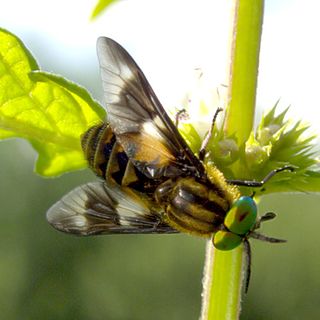
Superfamily Tabanoidea are insects in the order Diptera.
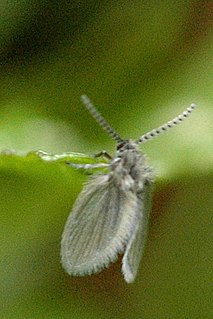
The Psychodinae are the nominate subfamily of moth flies (Psychodidae), also known as drain flies. Like most of their relatives, they are usually found in damp habitats; some occur in caves. The small larvae are aquatic or semi-terrestrial; the adults are winged and capable of flight. Psychodinae are found worldwide, including some subantarctic islands.

Pselliophora is a genus of true crane fly.

Pachygastrinae is a subfamily of flies in the family Stratiomyidae.
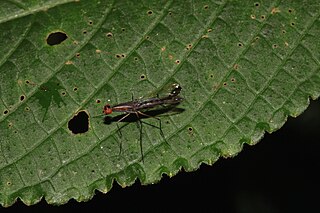
The family Nothybidae contains only the genus Nothybus, a group of colorful and elongated flies. The family has been recently revised.
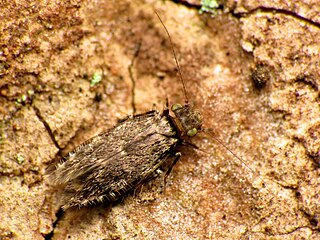
Lepidopsocidae are an insect family of bark lice belonging to the suborder Trogiomorpha. Colloquially, Lepidopsocidae are referred to as the Scaly-winged Barklice. There are more than 220 species described worldwide. Phylogenetic DNA analysis of relationships between families in Trogiomorpha propose that Lepidopsocidae is monophyletic, meaning that the taxa within all share a common ancestor. This is supported morphologically by the presence of scales and setae covering the body and forewings of Lepodopsocids. Sister families of Lepidoposcidae include Trogiidae and Psoquillidae.

Rainieria is a genus of stilt-legged flies in the family Micropezidae. There are at least 20 described species in Rainieria.
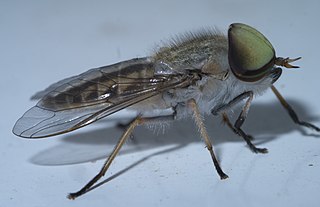
Tabaninae is a subfamily of horse flies in the family Tabanidae. There are more than 3000 described species in Tabaninae.
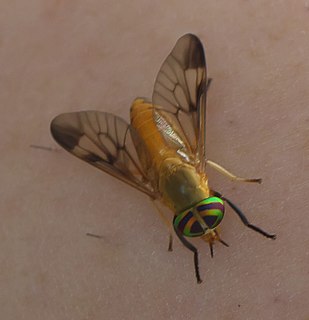
Diachlorini is a tribe of horse flies in the family Tabanidae. There are more than 50 genera in Diachlorini.

Tabanini is a tribe of horse and deer flies in the family Tabanidae. There are at least 220 described species in Tabanini.

Grallipeza is a genus of stilt-legged flies in the family Micropezidae. There are at least 40 described species in Grallipeza.

Plastotephritinae is a subfamily of flies (Diptera) in the family Platystomatidae, which currently includes 18 genera.
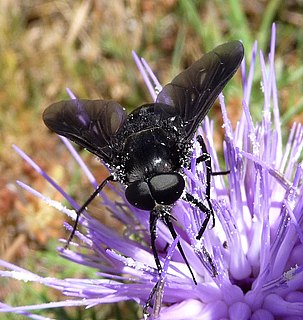
Pangoniinae is a subfamily of horse flies in the order Diptera, containing at least four tribes and 24 genera.
Chaetonerius is a genus of flies in the family Neriidae.


















